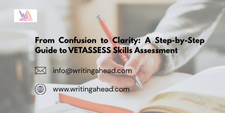If you’re planning to migrate to Australia under the skilled migration program and your occupation falls under the general professional category, then you’re likely to encounter one name early in your journey — VETASSESS. For many, understanding the VETASSESS skills assessment process can be confusing at first. But with the right guidance, you can move from uncertainty to confidence. This blog breaks down the assessment process step-by-step, helping you prepare effectively and avoid common mistakes. Whether you’re applying directly or using a support service, this is your roadmap to clarity.
🧩 What Is VETASSESS?
VETASSESS Australia is the official skills assessing authority for over 300 general occupations. It evaluates whether your qualifications and work experience meet Australian standards, based on the requirements of the occupation you’ve nominated under the ANZSCO (Australian and New Zealand Standard Classification of Occupations) list.
You must receive a positive VETASSESS skills assessment before submitting your visa application for many Australian skilled migration visa subclasses, such as 189, 190, and 491.
✅ Step-by-Step Guide to the VETASSESS Skills Assessment Process
Step 1: Identify Your Correct Occupation
Your first step is to determine the ANZSCO code that best matches your profession. Each occupation has specific tasks, skill levels, and qualification requirements. Choosing the wrong code is one of the most common reasons applications get rejected — so don’t skip this part.
💡 Tip: Read the ANZSCO description carefully and match your duties to the listed responsibilities — not just the job title.
Step 2: Check the VETASSESS Requirements for Your Occupation
Once you’ve identified your occupation, go to the VETASSESS Australia website and download the specific requirements document for that occupation. This will tell you:
The required educational level
The minimum number of years of experience
Whether your experience must be post-qualification
What kind of supporting evidence (like reference letters) is needed
Step 3: Gather and Organize Your Documents
You’ll need to submit a range of documents, including:
Certified copies of your qualifications
Employment reference letters
Payslips and tax records
CV/resume
Passport identification page
Qualification transcripts
Ensure that all documents are translated into English if they’re in another language, and certified according to the VETASSESS guidelines.
Step 4: Prepare Your Employment References Properly
VETASSESS requires detailed reference letters from your past and current employers. These must clearly outline your:
Job title
Employment dates (start and end)
Hours worked per week (full-time or part-time)
Specific duties and responsibilities (matching ANZSCO)
Company details and contact information
💡 Tip: Duties that don’t align with your ANZSCO description could lead to rejection, even if you were employed full-time.
Step 5: Create an Online Account and Submit Your Application
Head to the VETASSESS website, create your profile, and fill out the online application. Choose the correct service category (either “Qualification and Employment” or “Qualification Only”).
Upload all documents, review your entries, and pay the required fee (usually between AUD 900 and 1,000 depending on your assessment type).
Step 6: Wait for Assessment Outcome
Once submitted, VETASSESS will review your documents and verify the information. Processing times typically range from 8 to 12 weeks, depending on the occupation and volume of applications.
You’ll receive an email with your assessment outcome, which will be either:
Positive – you meet the required standard
Negative – your qualification or work experience is insufficient
Step 7: Use the Result for Your Visa Application
If your assessment is positive, congratulations! You can now use this result in your visa application or state nomination. If your result is negative, you can request a review or get professional help to reapply.
🎯 Why Is This Process So Important?
Your VETASSESS skills assessment is more than just a formality. It confirms your eligibility and contributes to your overall points in the skilled migration system. Without it, you cannot lodge your visa application — even if you meet every other requirement.
That’s why many applicants rely on expert support from migration services or platforms like WritingAhead, which assist with documentation, ANZSCO matching, and submission accuracy to reduce the risk of delays or rejection.
🧠 Final Thoughts: From Confusion to Confidence
Yes, the skills assessment VETASSESS process can feel overwhelming at first — with all the document requirements, technical terms, and deadlines. But once you break it down and follow each step carefully, it becomes much more manageable.
By investing time in understanding the process and getting your documents right from the beginning, you can avoid costly mistakes and set yourself on the right path toward a successful Australian PR application.
 :
https://www.pinterest.com/
:
https://www.pinterest.com/

